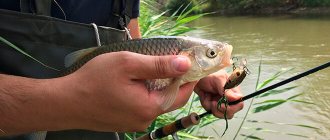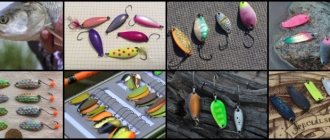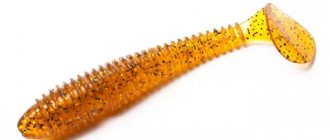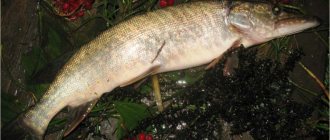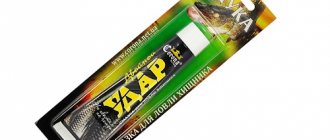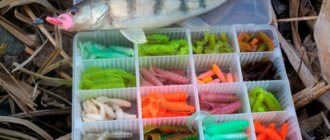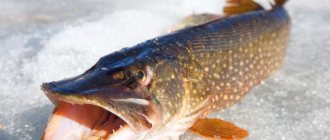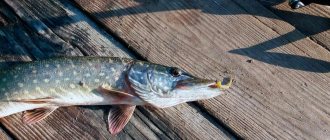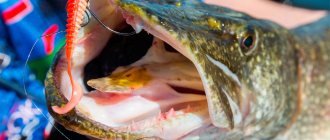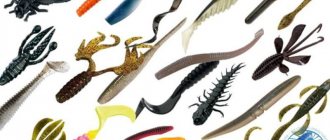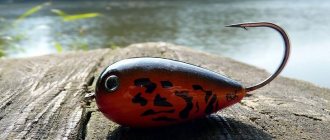Colors and patterns of wobblers - which ones to choose?
Since wobblers are the most “colored” baits, we will assume that the color of the wobbler is the main color of its body (silver, golden, lemon...), and the color of the wobbler is the combination of the main color with other color elements (back, belly, dots, stripes ...). In this case, the main colors of the wobbler - taking into account its visibility for the attacking predator - will be the color of the sides and the color of the belly of the bait. The color of the back is more important for the fisherman - he sees the bait better in clear water from the front and above, and visual contact is always useful when fishing.
True, it is not easy to determine the main color for some wobblers “perch” or “trout”, so here it is more correct to talk about special colors.
The question of the color of lures is still ambiguously perceived even by famous masters. Although most agree that the color of the bait is important for the fish. And it is especially important for wobblers, because these baits can even specially stop for a few seconds so that the predator can examine and grab the prey. Otherwise, why do fish have eyes?
It’s not for nothing that well-known manufacturers make at least 5, usually up to 10-15, and often up to 30 colors for the most popular models. There is also a commercial interest in this - spinners are a gambling people, they are always ready to buy a couple of new colors of their favorite wobbler. But there is also a justified expansion of the color range.
For example, now some wobblers are painted with “ultraviolet” colors, which are more clearly visible in daylight and are often more catchy
Raid Level Vib
Recently, many models of a wide variety of vibes have been released, I have caught and still fish with many of them, but so far none of them have left a special mark in my memory: just good working vibes, nothing more. But everything changed when the Raid Level Vib rattlin fell into my hands (photo 2).
Photo 2
When I first saw it, I didn’t expect anything extraordinary from the new bait - I just liked the vibe in appearance, but the very first fishing trips with the new bait pleasantly surprised me. And now, after a couple of seasons of its use, I can say that there is no better rattlin in my box - of course, for certain fishing conditions.
In general, Raid Japan vibes are currently at the top among anglers in the Land of the Rising Sun, and all of them were developed by Takashi Kanamori, a famous angler and popularizer of coastal bass fishing. And when fishing on the shore, as you know, the distance to which you can throw the bait sometimes plays a decisive role, and being undershot by a couple of meters can easily deprive you of the desired bite.
That is why all the wobblers of this company have excellent flight characteristics - special emphasis was placed on this during their development, moreover, they are very stable in operation and attractive to fish, i.e. catchers.
Let's start with the flight characteristics: with a fairly small mass, this rattlin is configured in such a way that it can be thrown very far and accurately, even in strong crosswinds. When fishing by boat, all this plays a secondary role, but when fishing on the shore, sometimes it decides the success of the entire fishing: placing the bait far and accurately, for example, under the edge of the opposite bank on a medium-sized river, is sometimes worth a lot.
Level Vib is already at the lowest speed, which is very important, and is ideal for fishing depths from a meter to three, but I have also used it when fishing holes up to five meters deep. Moreover, what’s interesting is that he catches pike in a variety of stages of its activity, you just need to select the wiring. This rattlin is also very fond of pike perch, both lake (photo 3) and those living in the vastness of reservoirs.
Photo 3
I don’t remember at all that small perch would take on Level Vib, but large ones are very partial to this vibe: at shallow depths, for example, this is my number one for humpback whales. When fishing, I often conducted comparative tests of different models of vibs, but the Level Vib rattlin in most cases prevailed in terms of the number of bites - that is why I have it in many colors and modifications (photo 4).
Photo 4
All three versions of this bait weigh the same - 10.5 g each - and catch equally well. The first is the quiet Level Vib Silence, then comes the Level Vib BIG, which has an internal chamber with several small balls that emit an unobtrusive noise during wiring, and the third is the Level Vib Counter, the loudest, with a large ball added to the chamber. It is impossible not to mention the tees of the models in this line: although they look flimsy, in fact they perfectly hold a five-kilogram pike even when force-fishing, and they are also unusually sharp and simply stick to the fish.
I use these rattlins in different situations. Let's say, I use the large Level Vib BIG model at depths of three meters, mainly when fishing along the relief - it works very stably: its main clients are pike, pike perch and catfish, although sometimes large perch also fly in. Over a couple of years of heavy use, there were several fishing trips when, in the event of a bad predator bite, this vibration literally saved me - this happened in the upper reaches of a large reservoir, and on small lakes, and on small rivers.
Wobbler body and color
The main element that attracts a predator with its appearance and corresponding game is the body (or body) of the wobbler. Therefore, the body is made to resemble the intended prey. In most cases it is a fish, sometimes something else: a crustacean, an insect, etc. Often, for more active play, a movable composite body of two or more parts is used.
For final resemblance, the bait is covered with foil “under the scales” and painted, and then covered with a protective layer of varnish. Special holographic coatings are increasingly being used, almost identical in color and shine to live fish.
Now let's talk in general terms about the color of wobblers. There are so many coloring options for them that even experts sometimes get confused. Therefore, the easiest way is to first identify 3 main groups: natural, exotic and combined coloring.
Level Сrank Mid
For fishing in deeper places, there is a version of this crank called the Level Crank Mid, which goes when retrieving one and a half to two meters - depending on the thickness of the cord used and the distance at which the bait is thrown. By the way, both versions of this crank are equipped with the same size 8 treble hooks that the Level Vib is equipped with – they are extremely tenacious and hold fish well. In terms of “game”, the deep-sea version is even a little more active than its shallow-sea brother, because its deepening blade is larger in area (photo 7), and the crank starts almost instantly.
Photo 7
It casts well, quickly gains its working horizon and goes in it until it exits the water, catching consistently - a kind of standard medium-sized crank for a wide variety of predators. With this version, I still have less experience than with shallow water, but pike and perch were caught perfectly on the Level Crank Mid - this is the first bait that I will use when fishing with cranks at medium depths.
If the task was to choose one single pike minnow, as they say, for all occasions, it, oddly enough, would not be a purebred “Japanese” at all. My long-term leader in pike on any body of water and at any time of the year is the Chinese minnow wobbler TsuYoki Mover 128SP, which has helped me out more than once in the most seemingly hopeless situations.
Natural colors of wobblers
Natural coloring completely replicates the appearance of their living prototypes. Up to 80% of baits are painted “naturally” (Fig. 1).
In this case, the main coloring is most often used - a dark back, shiny sides and a white belly (Fig. 1a). It has three main options: silver, gold and copper. Wobblers in these colors imitate most forage fish, including “white” bleak, “yellow” roach and “reddish” crucian carp.
Special colors for perch, trout and minnow are often used (Fig. 1b, c, d).
Fig.1. Natural colors of wobblers: a) main; special: b) perch, c) trout, d) minnow.
Natural colors are especially effective in clear water and sufficient lighting.
The latest squeak is “natural” translucent wobblers for fishing in bright sun. In this case, only part of the bait is slightly colored: the head, back, sparse scales - the rest is left transparent.
Choosing a wobbler by color
In the off-season, all spinning fishermen are waiting for the ice to melt from the lakes and rivers, the water to warm up and, taking the spinning rod in hand, they will be able to relax on fishing. During this period, active preparations are underway for the new season: rods, reels, and bait are purchased. And if ten years ago it was impossible to choose something, now the market offers us such a choice that you no longer know what you need.
There are more than one hundred types of wobblers, and in combination with coloring - tens of times more. Therefore, when an experienced spinning angler buys a wobbler, he has no particular doubt about which color to choose, since he already instinctively senses whether it is “working” or not, and a novice angler simply gets confused in this variety.
Most often, novice spinning anglers listen to the advice of more experienced comrades or try to follow the rules taken from fishing literature. But for different types of fish and different fishing conditions, the color of the wobbler is different. Therefore, the author of this note decided to analyze his experience of fishing with wobblers and give some advice to beginners regarding the choice of wobbler color. In this case, depths of up to 3 meters are taken into account, as they are most often used when fishing with a spinning rod. In addition, at depths of more than 3 meters, some colors no longer become so noticeable, are absorbed by other colors, and casting with wobblers becomes ineffective.
First, let's look at the fishing conditions, regardless of the type of fish. And, perhaps, you have already heard or read some of the following somewhere, but think about whether you have used it in practice. So, a few basic rules:
Determine the basis of the food diet of the object of your fishing. For example, you are fishing for pike in a lake that has a large population of perch. The most effective color will be the “perch” color, as well as combinations of black, green, yellow and orange. By the way, these same colors will also be effective for catching perch in this body of water.
Pay attention to the color of the bottom and the transparency of the water. The general recommendations here are as follows: the darker the color of the bottom and the muddier the water, the darker and more saturated the color of the wobbler should be. For example, when catching perch in two different bodies of water, you notice that in one water the perch has a dark color (these are mainly lakes with a dark ground cover and rich vegetation), and in the other water it is light in color (usually in rivers with a sandy bottom). In the first case, the dominant coloring will be the dark, rich color of the wobbler (variations of black, brown, green, red, orange, or better yet, holographic coloring). In the other there are light and pale colors (white, gray, light yellow, pale brown and light green). The same applies to the transparency of the water - the clearer the water, the lighter and more natural the color should be.
Determine the water temperature. Let's remember the basics of fish physiology. These are, first of all, cold-blooded organisms. Therefore, the warmer the water, the more active the fish are, and the colors in such conditions should be bright. These are combinations of yellow, orange, red, green colors. Fish notice them from a great distance and are attracted to them. Cold water – cold and pale colors. These are white, blue, gray, light brown shades.
Look up. Depending on the color of the sky and the weather condition, the coloring of your wobbler should also be different. In sunny weather with a clear sky, dark tones will be more effective, because the fish most often attacks from the bottom up and sees the bait against the background of a light sky, and dark tones are much more noticeable. Some professionals recommend using black, but the author's personal experience does not support this color. Apparently, this color is already too noticeable and lifeless against the background of a light sky. Therefore, it is better not to use it. In gloomy weather, light colors perform best - white, silver, light brown, light green, pale yellow and their combinations.
The effectiveness of wobbler coloring depending on the type of fish
Pike
Let's start with it, as the main object of fishing for spinning rods. Despite the aggressiveness and greed of pike, the color of the wobbler has a great influence on the size of your catch. Fishing on the same lake for a long time, the author noticed that in different conditions, wobblers of different colors of the “Slider” model from the company “Salmo”, on which pike were often caught, worked with different efficiency. In sunny weather and especially in clear water, the wobbler “Salmo Slider SD7S” (dark gray back, yellowish sides and white belly) won in comparison with the wobbler “Salmo Slider SD6F” (dark back, green-yellow sides with black tiger spots and orange belly). But when the water bloomed or became cloudy, especially after heavy rains, and the fish became passive, the Salmo Slider SD6F wobbler lured the vast majority of pikes. Moreover, the bite on wobblers of natural colors was worse.
In conditions of muddy water or bad weather, the “green and fiery tiger” color gives a good result, a little worse than the “Red Head”. Bright saturated colors: green, orange, yellow, raspberry and light green in different combinations, the so-called “clown” colors, undoubtedly the best during the flowering period. If the water is clear and its temperature does not exceed 20 degrees, natural colors show themselves best: “for pike, perch, roach, depending on the main food item of the pike. But it should be noted that the colors should not be too bright and sharp; it is better if they are faded and blurry.
Okyn
The choice of wobbler is similar to that for pike, but avoid too shiny holographic or golden colors. Since, experimenting with baits of different colors, we can say with confidence that such colors are ineffective when catching perch compared to other fish. In general, in dark fishing conditions (evening twilight, gloomy sky, the period of flowering water) the “green tiger” showed itself best, and in light weather and clear water – the natural “roach” with a pink or red belly. But the most universal color is still the color for the perch.
Asp
This fish is very careful and does not allow you to get close to it, and wobblers, as you know, do not have the best aerodynamic characteristics. Therefore, it is mainly caught with such classic baits as “Kastmaster” from. But there are fishing conditions in which a properly selected wobbler can even “catch”. Let's say you are fishing at a bend in the river. In this case, you can successfully fish by rafting, floating the wobbler downstream under coastal bushes or to other places where the fish are located. Requirements for wobblers relate to shape, depth and coloring. Regarding the shape and depth, it is clear that these should be shallow-water wobblers. Coloring is no less important than the two previous points, since the asp has very developed vision. Therefore, natural colors show themselves best. As a basic one, it’s best to take “under the bleak” or something similar.
Chub and ide
When catching these types of fish, there are no differences regarding the choice of bait colors. Many people prefer natural colors - “like bleak or roach” or combinations of shades of brown, green and black. That is, guided by what the fish eats. If the fish are located far from the shore (on a rift), then it is better to choose natural colors for white fish fry. In another case, when fishing under overhanging trees or near coastal bushes (especially during the period of mass emergence of cockchafers), the best choice is the combined colors of black, brown, gray interspersed with yellow or green. That is, dark tones should predominate. It often happens that the fish immediately reacts to the fall of a wobbler of this color with an instant grip. It is worth paying attention to the fact that bright red and yellow colors are ineffective when fishing for ide and chub during the day. Obviously, this is due to the fact that these colors in the natural color of insects and beetles signal their inedibility or toxicity. Therefore, it is better to avoid such flowers.
And finally, a few more tips:
— Holographic coloring is best used when fishing in gloomy weather or in muddy water.
— In order to know which colors of wobblers are most effective in different fishing conditions, it is better to have several colors of a certain model of wobbler of which you are confident of catchability, rather than many different models with different colors. This way you will quickly learn about the effectiveness of certain colors in different fishing conditions. — Experiment with different colors not when the bite is weak and “there is nothing to do,” but during the period of good bite. With intense biting, it is much easier to determine which color is most effective. — When choosing the coloring of a wobbler, take one so that the color transitions are smooth, and the outlines of the wobbler’s body are not clear, as if blurred. This wobbler looks more natural in water. It’s good if there are partial inclusions on the wobbler’s body that contrast with the main colors.
Happy fishing!
Exotic colors of wobblers
The exotic coloring doesn't even come close to resembling any real fish. However, almost all predators react to them: either out of great hunger, or out of curiosity, or defending their territory from “aliens.” Most often, exotics are rainbow, “tiger” or spotted (Fig. 2).
Fig.2. Exotic colors of wobblers: a) rainbow, b) “tiger”, c) spotted.
There is no doubt that sometimes (as a rule, not often) the catch with wobblers of exotic colors significantly exceeds the catch with the same models of “natural” colors. However, in the vast majority of cases, predators clearly prefer baits of familiar “native” colors.
What kind of fish can you catch with wobblers?
A wobbler is the best bait for large predators. Having several different models in your arsenal, you can safely go out to catch pike, asp or pike perch. However, in order to get the coveted trophy, you should take a responsible approach to the choice of bait, which largely depends on the time of year and fishing technique.
- Pike . This large freshwater predator is excellent for spinning. In the spring (after spawning) it is better to catch it with small sinking wobblers, using a leisurely retrieve with pauses. In summer, the same leisurely retrieve and brightly colored floating wobblers are effective. In autumn, it is recommended to fish with deep-sea fatties, shads and minnows of natural colors, diving to a depth of 6 meters;
- Sudak . This strong fish is a desirable prey for many anglers. To catch pike perch, you need to choose wobblers that look like fry or bleak. By depth of burial - SSR or SR. As for the size of the bait, it all depends on the size of the fish. Wiring - horizontal with minimal acceleration;
. This predator, leading a gregarious lifestyle, loves water shelters. It is caught well on small crankbaits (SR and DR), minnows, shads, poppers, and jigs. The choice of gear is of great importance. Optimally, a rod with a medium or slow action, the test weight should not exceed 15 grams, the reel should be inertia-free, the cord should be braided with a diameter of 0.14 mm;
Perch- Chub . And here, when choosing the most catchy wobbler, you should take into account the season. At the end of May and beginning of June, small minnows are good. At the height of summer, it is better to choose larger baits. In the fall you can fish for cicadas that imitate tadpoles, waterfowl and flying beetles. In general, different wobblers are suitable for catching chub: poppers, rattlins, darters, jerkbaits. The main thing is to choose the right place. You should look for the predator near steep banks, near sharp turns of the river and rapids with a fast current;
- Asp . Floating models and suspenders are suitable for asp fishing. Color doesn’t matter much, but if hunting is done from a boat or under overhanging trees, then bright wobblers are beyond competition. Particularly interesting are models with pronounced animation. For example, Jackall Bros Cherry, Imakatsu Crank IK, Lucky Craft Flat CB MR.
The best wobblers for pike 2017-2018. Rating of Andrey Streltsov
Good afternoon, dear fishermen. I would like to share my experience and rating of the best wobblers...
100147
1
The most popular wobblers for chub
Fishing on small rivers from early spring until the end of autumn, in my opinion...
18357
0
The best wobblers for perch. Reviews, rating, reviews
Every year there are more and more fans of catching predators with artificial lures such as “wobblers”. How …
43201
1
Don't get tired of experimenting. Wobbler is an ambiguous bait that does not accept clear rules. That's what makes her interesting. Try it, look for your own fishing methods and then luck will not keep you waiting. You definitely won't be left without a catch!
Combined colors of wobblers
Combined coloring pages include both natural and exotic colors. As a rule, here bright details are applied to the natural main background, for example: a yellow back, an orange belly, a red head, contrasting dots or stripes on the sides, etc. (Fig. 3).
Fig.3. Combined colors of wobblers: a) red head, b) bright back and belly, c) contrasting details on the sides
It is believed that in many cases, for example in muddy water or in low light, the fish will notice a brighter and more contrasting wobbler more quickly, and the natural main background of the bait will not arouse unnecessary suspicion in the predator.
In addition, the bright back of a shallow-running wobbler is almost invisible to the fish, but visible to the angler. This allows you to visually control the wiring and even see a “soft” bite in pursuit, when a bright spot in the water suddenly disappears somewhere.
There is also an opinion that under different lighting conditions, fish perceive either light or dark tones. According to this theory, the contrasting “red head” with a mother-of-pearl body is clearly visible in any conditions. And indeed, such wobblers are very catchy: they are not inferior to monochromatic ones, and at some moments even surpass them. Moreover, red and white bait is recognized by all our predators from perch to catfish, which I have witnessed many times.
Returning to the overall picture, from personal experience I will say that in approximately 50% of cases the best results were given by natural colors, in 25% by combined colors, and only in 25% by exotic colors.
Level Crank Raid
It must be said that this crank is generally unique - few companies can boast of a slowly sinking paddle crank; for some reason, all wobblers of this type are produced exclusively floating.
The Level Crank flies just like a bullet, even in windy weather - among cranks it is my undisputed leader in terms of casting range and accuracy of hitting the target. It begins to actively “play” from the very first centimeters of wiring, and at the slowest speed, it holds the wiring horizon very well, which with my cord is plus or minus a meter.
Photo 6
What’s interesting is that it can be served to the fish in different ways: when the pike’s activity is low, for example, I often twitch the crank with small jerks with the tip of the spinning rod - on such a retrieve it literally turns in one place with a gorgeous rolling. It is interesting that such a shallow-water crank, due to its negative buoyancy, can be carried below the specified depth - I have more than once fished with this crank at depths of up to three to four meters, letting it sink to the bottom, and then casting with pauses in the bottom layer.
Pike and perch love the Level Crank, and even with low predator activity, a few bites can always be seen. What’s interesting is that with such a small crank size, it constantly catches quite large pike, 3–5 kg each.
How to choose the best wobbler colors
For a wobbler, the choice of color is especially important. After all, this bait is the “slowest”; it is often carried out with long stops and hovering right under the nose of the predator. In such cases, the appearance of the wobbler should not cause additional suspicion.
We have already spoken in general terms about the principles of choosing bait colors. In relation to wobblers, these principles can be specified, namely:
- The color of the wobbler should resemble the main food source of the predator in a given body of water. For example, “for bleak and silver bream” it is better to take a silver wobbler, “for roach and tongue” - golden, “for crucian carp” - a reddish one.
- Pike and perch often feed on their relatives. Therefore, a wobbler “for perch” will be very appropriate for these predators. I’ll add that this is one of my favorite colors.
- Usually in the morning, evening and in cloudy weather, fish are more attracted to light and shiny silver wobblers. But in the sun, such baits shine unnaturally brightly, so it is better to use duller colors - golden, bronze, etc. The mother-of-pearl version with red and blue specks “like trout” allows you to successfully fish in any light.
- Two-color coloring of wobblers is more universal, especially “red head - pearl body”.
- Contrasting dots and stripes on the main background make the wobbler more visible to fish.
- At great depths, bright “acid” colors – yellow and green – are better visible. This is one of the best colors for walleye.
- In muddy water, yellow, red and black colors, and especially their combinations, are more noticeable.
- Dark colors always work better near the surface. For an asp, for example, you can take a dark gray wobbler, for a chub - a black one.
- In warm water, a wobbler with red elements often helps out, in cold water - with blue ones.
- The more active the predator, the brighter the wobbler can be. The brightest and largest wobblers are used during the feeding season.
Choosing a color for the fishing conditions
There is no consensus
on the question of how important the color Some people believe that color, like smell, is of great importance .
Others carefully select the type of bait for the fishing conditions and try to make it as attractive as possible during fishing, not paying attention to the color. Let's figure out who is right and who is wrong and find out what color pike likes.
In reality, coloring affects the size of the catch , and attention .
First of all, take into account the general rules for selecting colors for pike, which relevant when catching predators:
- on bright sunny days, models with dull colors work better;
- in cloudy weather, bright ;
- dark- models are suitable for fishing in dark water ;
- when the water is cloudy, preference should be given to bright colors, including acidic ones .
Bright lures and spinners that reflect light work great on cloudy days and in murky water, as they are most visible to predators. For sunny weather and for illuminated shallow water in clear water, they are much worse , since flashy colors and sparkling metal in such conditions cause rejection .
Important .
It must be borne in mind that color plays a role primarily when fishing in clear water and shallow water. At depths greater than 5 meters it no longer matters. When fishing with jigs, preference should be given to baits that do not merge with the bottom . So, dark colors work on sandy soil. On a muddy bottom, in turn, the best results can be achieved with light ones .
